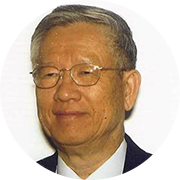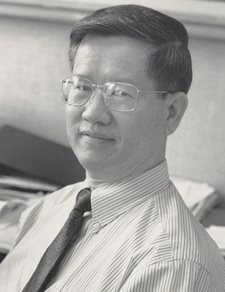 Over the course of 50 years, Kelvin Shen has had a remarkable career both with U.S. Borax and as an independent global consultant. He has been driven by a passion for detail and endless curiosity that has shaped the direction of his work—and the direction of product development within our company and across our customers’ industries.
Over the course of 50 years, Kelvin Shen has had a remarkable career both with U.S. Borax and as an independent global consultant. He has been driven by a passion for detail and endless curiosity that has shaped the direction of his work—and the direction of product development within our company and across our customers’ industries.
That drive for continuous learning and innovation has made him an authority on products that are part of our everyday life—and that, when made right, can even save lives: Fire-retardant polymers.
Fire retardancy research: An opportunity for meaningful impact
In 1972, when Kelvin came to work in our research laboratory, he was already a skilled chemist. He holds a PhD in organic chemistry from the University of Massachusetts at Amherst and completed his thesis work in organometallic chemistry and X-ray crystallography at Brookhaven National Laboratory in New York. He was a research fellow at Yale and Caltech, then taught at Drexel University and California State University at Los Angeles—all before joining U.S. Borax.
Initially, Kelvin was involved in herbicide synthesis and development. But in the mid-1970s, the conjunction of two seemingly unrelated events—the Federal Fire Prevention and Control Act of 1974 and the global energy crisis—took him down a different path.
Kelvin says, “In the 1970s, there was a severe energy shortage that opened up markets for energy-saving products such as insulation. Those products all had to meet fire safety standards, so I got involved in flame retardancy of cellulosic insulation for energy conservation.”
In the late 1960s, U.S. Borax had developed a pioneering fire retardant for use in fighting wildfires. That early product was the precursor to Firebrake® ZB, which was developed in 1972. This zinc borate-based fire retardant is highly adaptable to a wide range of applications, and soon, Kelvin was involved in developing formulations for using Firebrake ZB in various organic polymers.
That research proved highly valuable after a series of high-profile hotel fires, including the tragic 1980 fire in the MGM Grand hotel in Las Vegas. Those events revealed that stopping the flames was not enough. The toxic fumes and smoke released by smoldering materials—including insulation and a wide variety of polymer-based materials such as PVC piping, paint, and wiring—are just as deadly and can reach farther than the fire itself.
Zinc borate functions as a flame retardant, smoke suppressant, and afterglow combustion suppressant. This makes it a highly effective additive on its own. And, it has a strong synergistic effect with other fire retardants. It can partially or completely replace higher-cost additives such as antimony oxide.
Narrow focus, broad impact
“We knew there was a need for cost-effective fire retardants. But in our industry—as in many—products often aren’t adopted until they are promoted to the manufacturers who need them,” says Kelvin. “So I became involved in building a body of data and knowledge to support various uses of borate fire retardants.”
That educational effort became a lifelong journey.
Today, people use hundreds of different types of polymers in products such as wire and cable, flooring, roofing, foam insulation, PVC pipe, aircraft seating, protective coatings, electrical connectors—even fabrics. From appliances to cars to lighting to the phone in your pocket, polymers are everywhere. “And zinc borate is effective in most of them,” says Kelvin.
While fire safety in polymers might sound like a narrow focus, Kelvin says it’s been a remarkable and dynamic career for him. And over the years, as polymers have become more sophisticated and specialized, so have the fire retardancy measures we use to protect them.
Balancing cost, efficacy, and compliance
Changes in polymer production don’t always happen quickly. Manufacturers are always striving to find the right balance of cost, efficacy, and compliance. They must be able to adapt their formulations to maintain that balance as they meet the changing demands of consumers and regulations.
“That’s a key concern for all our customers,” Kelvin acknowledges. “Industrial producers are always looking for new and better solutions, and they typically adapt as their conditions change.”
Continually containing costs
He explains, “For example, say you’re adding a flame retardant to a PVC product—you need it to be less flammable and produce less smoke. Typically, PVC producers use antimony to reduce flammability. However, over the years, the cost of antimony has increased. In addition, concerns have emerged about potential toxicity related to antimony.
“Zinc borate can be used in conjunction with antimony, and in some cases, you can replace the antimony entirely. Zinc borate is less costly and also reduces smoking—so it’s gained in popularity with PVC producers.”
Staying effective and adaptable
Another area of ongoing concern for polymer manufacturers is whether to produce halogenated polymers (which contain elements such as chlorine and bromine). Those formulations have properties that are particularly suited to certain types of applications. But they pose risks because they can release toxic substances, especially in a fire. As manufacturers look for ways to adapt their products to non-halogenated formulations, they often come to experts like Kelvin to determine how to make that shift.
“At the time that the 1974 fire prevention act was made law, we were using halogen-based polymers for nearly every application,” says Kelvin. “What we didn’t realize that smoke is just as dangerous—or more so—than the flames.
“If you treat a piece of furniture, for example, a fire retardant will reduce the start and spread of flames in the urethane foam—so you have more time to escape the fire. But at the same time, many common additives allow a great deal of smoke production—and the fumes that those additives produce in conjunction with the components of the halogenated polymer itself are highly toxic.
“Fortunately, borates are about equally effective as fire retardants in halogenated polymers and halogen-free products,” Kelvin adds. “So, even in industries that have been slow to transition away from halogenated polymers, we have been able to offer solutions.”
Tackling emerging challenges for polymer manufacturers
As Kelvin ponders the trajectory of the polymer market, he is keenly aware that new challenges always offer the opportunity for innovation.
 “For example, today, everyone is focused on sustainability and ‘circular’ resource use,” he says. Polymers and plastics are under particular scrutiny. “People want to be able to reuse and recycle them,” he says, “and in some cases, parts can be removed from products and simply reused.”
“For example, today, everyone is focused on sustainability and ‘circular’ resource use,” he says. Polymers and plastics are under particular scrutiny. “People want to be able to reuse and recycle them,” he says, “and in some cases, parts can be removed from products and simply reused.”
But Kevin explains that there are serious challenges for recyclability. “Most proactive recycling is actually done in the manufacturing plant—when parts are scrapped during the production process, they can be recycled then. But when you recycle a polymer, you subject it to that heated process all over again, which changes its properties too. So it’s more difficult than most people understand to create an effective way to reuse those materials.”
To find solutions to such complex challenges, manufacturers need access to deep expertise—and Kelvin is a rich source of knowledge and experience. Over the course of his career, he’s seen tremendous changes and solved myriad problems. So when he’s presented with a new question or challenge by a customer, he often has a solution—or can recommend an approach that suits a highly specific need.
“Whenever I talk to customers, I spend time reading recent and relevant research, so that they know they can talk to me with confidence,” Kelvin notes. “You have to be knowledgeable when you talk to customers—you have to let them know you have spent the time to understand their needs.”
“It’s gratifying to get a response from a customer saying my idea worked,” he says. Of course, he also wants to hear when a recommendation didn’t work—or when a new approach is needed. That sets him in motion again, sifting through data and literature and seeking the next insight.
Always seeking the next answer
“As a researcher, you’re building a body of data to help manufacturers make those kinds of transitions,” he says. “Because I and U.S. Borax have such a large body of knowledge now, any manufacturer can come to us for answers about how to best use zinc borate in their particular application—whether alone or in conjunction with other additives.
“One of the most important things to understand is that we learn from every one of these interactions. We’ll get a question—and often we have the answer because we have so much existing data. But if we don’t, we take the time to review current literature, explore industry publications, and find the answer they need.”
Kelvin says that those questions—and the ongoing search for the next answer—are what keeps him engaged in his work. “This is a field where I am always learning—we attend conferences, read reports, and review new patents all the time—and continue to gather data to build that valuable information.&rdquo
“We all learn on the job,” he says. “For someone with 50 years in the field, it’s good to feel I’m always learning.”
Kelvin is a collaborative problem solver and communicator who fosters innovation through endless curiosity. We are proud to celebrate Kelvin and his amazing—ongoing—career. He is truly the embodiment of the spirit of innovation at U.S. Borax.
Resources